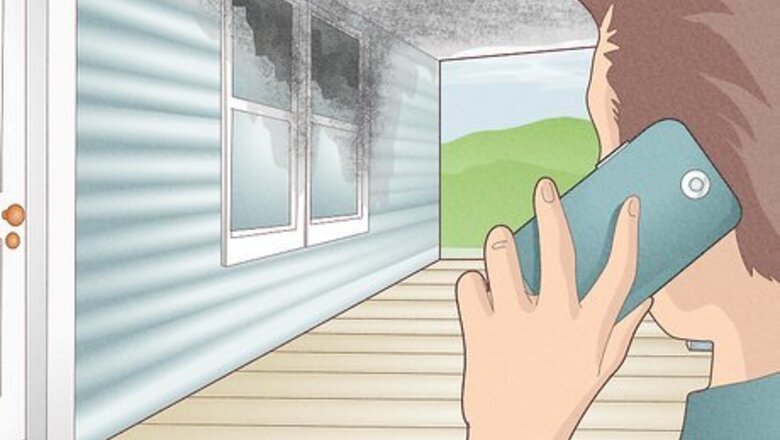
views
Beginning the Cleaning Process After a Fire
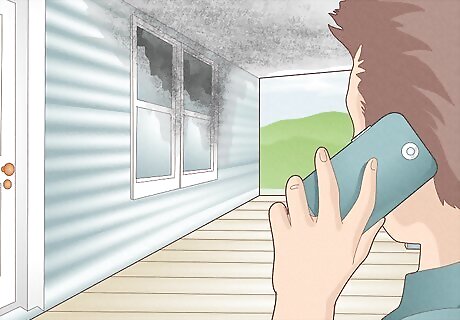
Get permission from a fire marshal to safely re-enter your home. Do not enter a house or other building affected by fire until you have received word from a professional that it is safe to do so. How soon after a fire you are allowed back in the building will depend on the severity of the fire and the measures employed to put the fire out. Assess the damage to your belongings once you are back inside. Decide what you want to try to clean, and what you need to discard.
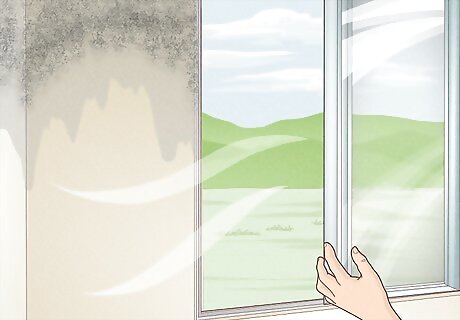
Allow fresh air to circulate. As soon as possible, open windows in each room for increased ventilation and bring in a small fan to increase the amount of air flow into the room. This will help clear the building of any residual smoke, minimize the smoke odor, and provide fresh and soot-free air for you to breathe. Run a dehumidifier with the windows closed if you live in a climate with warm, humid weather and have associated water damage along with smoke damage. In this situation, multiple powerful fans will be key. Change your furnace filter daily if your heat is running. Do this until it the filter shows no soot.
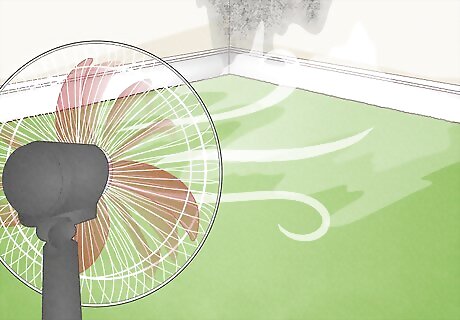
Dry wet items before attempting to clean smoke damage. Fans and dehumidifiers will help with this task. However, if water hoses were used to put out the fire, it may be best to hire professionals to do fire/water damage combination cleanup. Contact your insurance company for approved restoration contractors that you can contact. Visit the Better Business Bureau website or Angie’s list to find trustworthy contractors. If you attempt to dry out your house yourself, beware of any mold or mildew underneath beneath carpets and floors. Remove all carpets from the home. The presence of mold can be a serious health risk and can damage your floors beyond repair. If possible, invest in some large swamp fans to help dry and air out your home.
Cleaning Smoke Damage from Your Walls and Ceiling
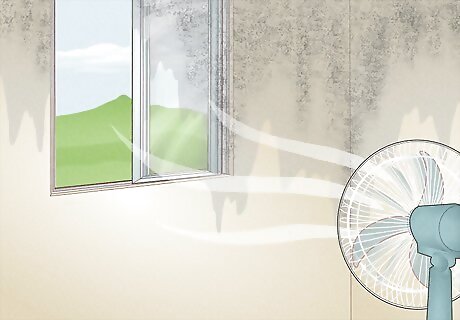
Ensure the area is properly ventilated. Combining harsh fumes from smoke with cleaning products can irritate your lungs, so make sure you have the windows open (if possible) and fans running to bring fresh air to the area in which you are working.
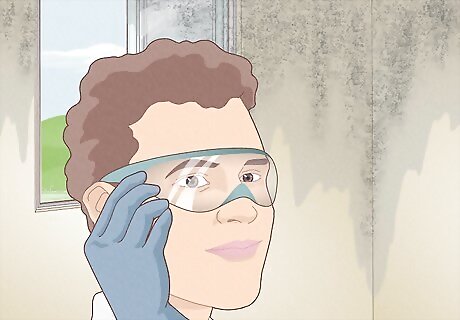
Wear safety goggles and heavy-duty gloves. Especially when cleaning your ceiling, safety goggles will prevent you getting soot in your eyes, while rubber gloves will protect your hands from cleaning chemicals. In addition, try to wear old clothes that you doing mind getting stained and ruined. A hat will protect your hair from dust and soot.
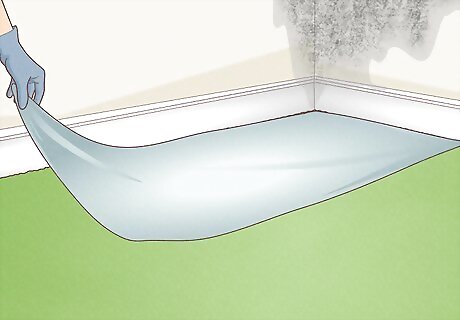
Place a drop-cloth on the floor. This will help to avoid transferring soot stains to the carpet or flooring.
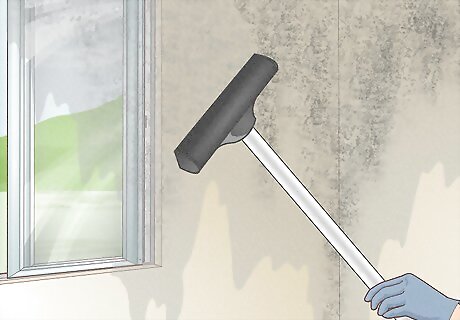
Get rid of loose soot on the surface of the walls. The first step to cleaning smoke damage is to remove any loose soot clinging to the walls. This can be done with a vacuum cleaner or with a dry chemical sponge. Fix the plain attachment onto the vacuum cleaner hose, and hold the nozzle slightly above the surface of the wall. Move it back and forth until all loose soot is removed. You may also want to try using the brush attachment to brush off any additional soot. Anything that is not sucked into your vacuum cleaner should fall on to your drop cloth. Try a dry chemical sponge as an alternative to vacuuming. This chemical sponge is highly recommended because it is impregnated with a chemical that removes soot and smoke from your wall. Using a dry sponge, wipe the soot stain on the wall repeatedly. When the sponge becomes saturated with soot, wash it out in a sink and allow to air dry. If there is severe soot damage on walls or ceilings, they may need to be replaced.
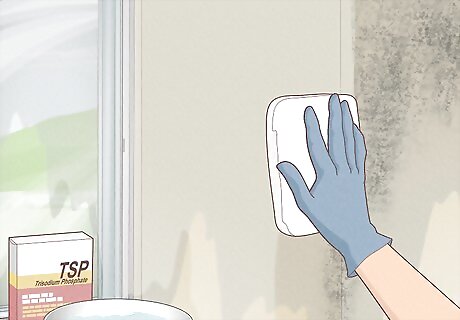
Remove soot with Trisodium Phosphate (TSP) solution. A popular cleaner for smoke-damaged walls is Trisodium Phosphate (TSP). While this is a more powerful cleaning solution, it still requires a great deal of time and effort to clean the damage to your walls and/or ceiling. Put on a pair of heavy duty gloves to protect your hands and forearms and a pair of goggles to protect your eyes. Wear old clothes that you don’t mind having ruined. Fill a standard bucket with 1 gallon warm water and add 1 tablespoon of TSP. Wet a sponge with the TSP solution and wipe your wall or ceiling vigorously with the sponge. Work one section at a time. Rinse the section you have just cleaned with a rag dipped in clean water. Continue until the entire wall and/or ceiling has been cleaned. Repeat the wash/rinse step several times depending on the severity of the soot buildup. Be cautious not to oversaturate your walls with water or let the water seep between your walls and baseboards. If the smoke damage is still visible after this cleaning process, you will likely need to prime your walls and/or ceiling and repaint. However, it is important to make sure they are as clean as possible before you do so. Beware that TSP is a harsh cleaner and can have irritating effects to skin and eyes. Be careful not to allow it to touch your skin, and if it does, wash it off immediately and be on the lookout for severe irritation.
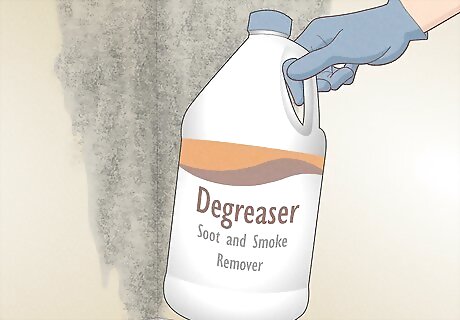
Look for a commercial cleaning product. There are many good commercial cleaning products designed to remove soot from walls as well as other surfaces. You can choose solutions that are heavy-duty for severe smoke damage, or that are gentle enough to be used around children and pets. A simple online search will provide many options, but here are some suggestions to start with: Unsmoke Degrease-All Degreaser: tough enough to remove the heaviest smoke damage. Benefect Atomic Degreaser: a solvent-free, high-performance botanical degreaser, safe for use around people and pets. Chemspec Smoke-Solv Liquid Wall Wash: specially formulated to remove soot and smoke residue from walls and hard surfaces.
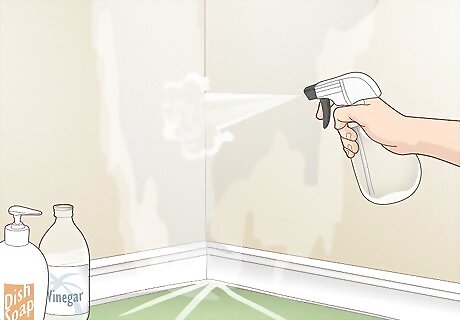
Attempt to remove the smoke odor from your walls. After you clean off the soot, you will need to deal with the smoke odor. Walls can absorb smoke and leak it back into the room. Several common household items, or those found easily in grocery stores, can be used to remove the stubborn smoke odor from the walls of your home, even if they don’t appear smoky or dirty at first. Place a plastic sheet around the base of the walls to avoid water seeping in between the walls and baseboards. Fill a bucket with warm water and add a few tablespoons of detergent, just enough so you create a few bubbles.. Wipe down walls with soapy water using a soft cloth or sponge. Use white vinegar as an alternative. Try wiping down washable walls with white vinegar (this can also be used on furniture and floors). Vinegar, while strong smelling itself, can be used as a powerful odor-neutralizer. Spray walls and surrounding area with Febreeze. Febreeze, sold in many stores, uses cyclodextrin to absorb odor. Try spraying the walls and affected area down with Febreeze to reduce smoke odor. The smell of Febreeze will be a welcome change from the odor of smoke!
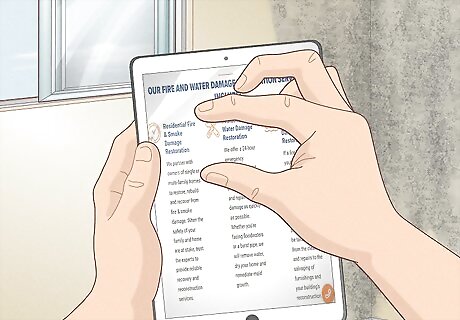
Consult a smoke damage professional if you have severe smoke damage in your home. While professional smoke damage repair can be costly and potentially unfriendly to the environment, there are companies that will employ environmentally-friendly smoke removal procedures. Look in the yellow pages or online under “Fire and Water Damage Restoration.”
Cleaning Smoke Damage from Household Textiles
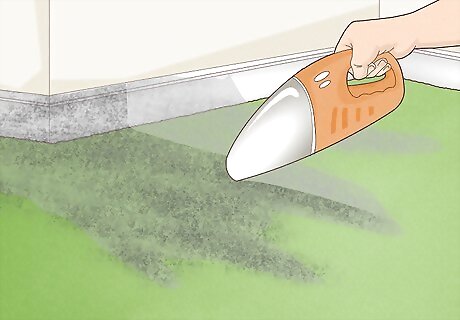
Remove soot from textiles with a vacuum cleaner. Hold the vacuum cleaner nozzle slightly above the surface of the upholstery, drapes, or carpet and move it back and forth across the item. Soot is oily and stains very easily so it will need to be removed as soon as possible, before any further cleaning or deodorizing occurs. Do not use vacuum attachments or an upright vacuum. The brushes tend to force soot further into fabrics and will make them much more difficult to clean. An upright vacuum will ground the soot into the fabric or carpet.
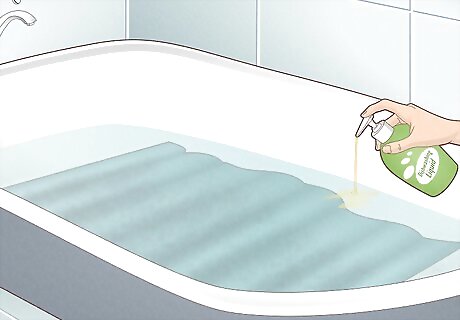
Deodorize household textiles. After the soot is removed from the surface of any furniture and textiles, you will want to deodorize these items. While professional assistance is recommended to make sure that the smoke odor is completely removed from these items, it is possible to attempt to deodorize them yourself using at-home methods. Dissolve 1 cup of dishwashing detergent in 1 gallon of warm water. Completely submerge all items (including furniture covers, curtains, etc.) and let them soak overnight in a washing machine or bathtub. Drain them and launder as usual the next day. For items that can be bleached, mix 4-6 tablespoons TSP with 1 cup Lysol or household bleach and 1 gallon of water. Add textile items, rinse with clear water, and dry. For especially stubborn odors, call a professional who will do an ozone treatment. This deodorizing treatment actually breaks up the smoke molecules to eliminate the order. This can be done by a professional fire restorer with an ozone generator. Talk to a local dry cleaner about using counteractants. Tell them that there has been smoke damage, and they can use these chemicals to remove odors from your textiles and clothing.
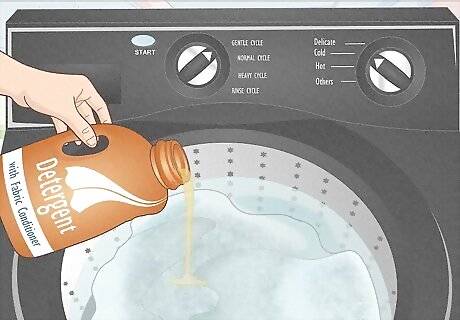
Clean household textiles thoroughly. After deodorizing, you will want to thoroughly clean all textiles. Take anything that is non-washable (including most draperies) to a dry cleaner for traditional dry cleaning. Wash any machine-washable items in warm water using your normal liquid detergent. Several washings may be needed to get these items as clean as possible.
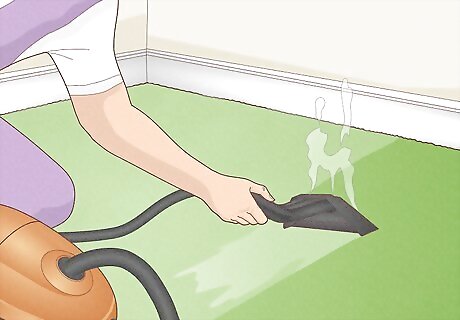
Have carpets cleaned professionally. After your carpets are fully dry, professional cleaning (which may need to be done twice, once after the fire to remove the soot and once after the rest of the restoration processes have taken place in the house) will help to make them as clean as possible. In some cases, you will need to remove the carpet because of mildew or mold on the floorboards underneath. It is highly recommended that you leave the carpet cleaning to the professionals to fully deodorize and rid your carpets of smoke damage.
Cleaning Smoke Damage from Clothing
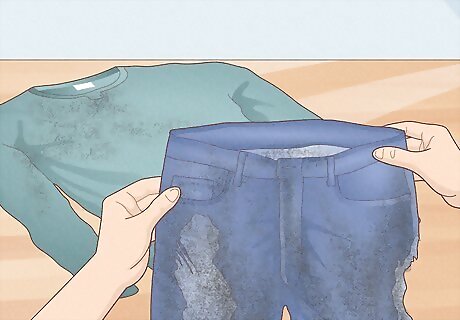
Sort what can be salvaged from what is beyond repair. Any clothing with burn holes or severe damage should be discarded. Sort clothes into piles based on their fabric types and washing instructions. Beware of any clothing that are dry-clean only, as these must be professionally treated.
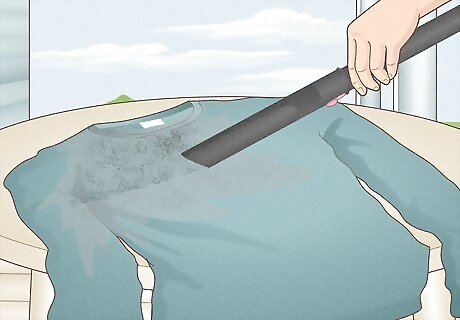
Remove as much soot as possible from your clothing. This can be done by taking clothing outside and giving it a gentle shake or by attaching the plain attachment to your vacuum cleaner and running it just over the surface of the clothing. Never use the brush attachment with your vacuum cleaner if removing the soot from clothing. The brush bristles can force particles of soot deeper into the clothing.
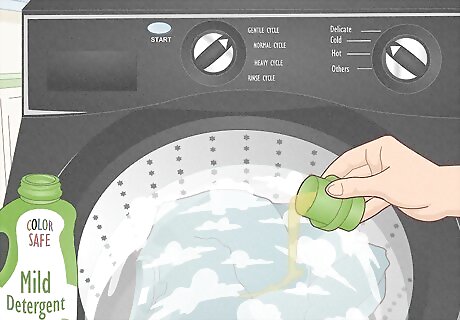
Clean smoke damage from your clothing. Controlled research has shown that fire damaged clothing is best cleaned by different methods according to the fabric content. Using a specific cleaning method tailored to the fabric content of your clothing will help salvage as much clothing as possible. Visibly smoke damaged clothing should be fully restored after 5 launderings. Use liquid detergent to return clothes to original state if they are 65/35 polyester-cotton blend, 50/50 polyester-cotton blend, or pure cotton. Use powder detergent and bleach (for bleachable clothing only) for clothing that is 65/35 polyester-cotton blend, 50/50 polyester-cotton blend, or pure cotton. Be aware that dry cleaning is non-effective with clothing that is 65/35 polyester-cotton blend, 50/50 polyester-cotton blend, or pure cotton. Recognize that 100% polyester fabrics may never be fully returned to their original state.
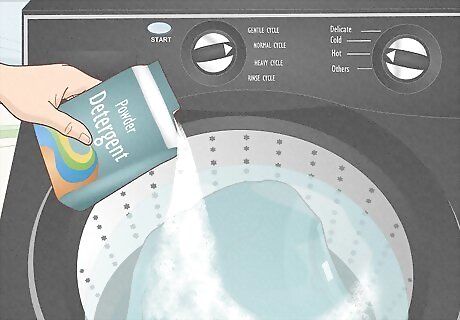
Deodorize your clothing. After your clothing is restored to its original appearance, it may still have a residual smoke odor. Washing your clothes in warm water with different detergents for 1-5 launderings can help you remove this smell. Use powder detergent or liquid detergent (with our without bleach) to get the smoke odor out of any type of washable clothing. Avoid using household deodorizers to remove the smell. These will only temporarily mask the smell.
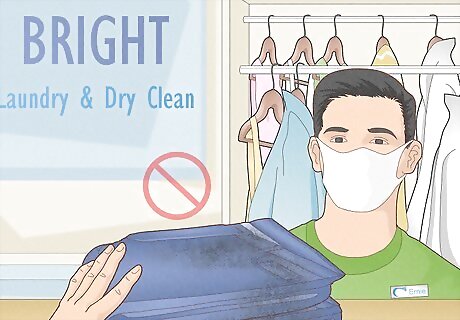
Avoid dry cleaning if possible. It will not fully remove the smoke odor from clothing. It is better to wash any clothing that is able to be washed yourself where you can put different items through as many washes as necessary to restore them to their original quality. That said, some dry cleaners can use special counteractants to remove odors from clothing. Talk to your dry cleaner to see if this option is available.
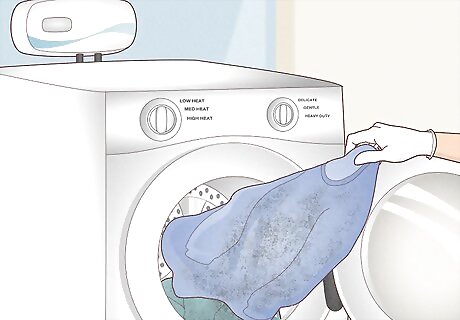
Contact a professional if the smell of smoke lingers. They will be able to perform an ozone treatment on your clothes that will destroy the smoke molecule and the smell as well.
Cleaning Smoke Damage from Furniture
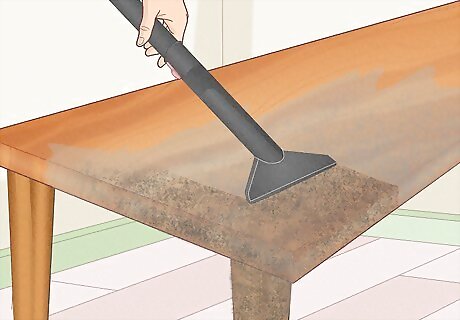
Clean your wood furniture. You will want to treat your wood furniture gently to avoid stripping off the finish or causing any permanent damage. Vacuum the soot off the furniture using a flat attachment. Do not rub the attachment along the wood, as this can grind soot into the wood. If your wood furniture is finished, you can consider using the brush attachment and gently rubbing the bristles along the surface of the furniture. Wipe the wood with a dry chemical sponge. This is similar to the process of removing soot from the walls. Wipe the dry sponge along the surface of the wood in straight lines until the sponge turns black with soot. Rinse the sponge and let it dry. Restore the wood with polish. Use a cream restoration polish for best results, and do not leave the cream on the wood for more than 5-10 minutes. Consider using a polish like Restore It Cream Furniture Polish. You can also use a spray like Pledge.
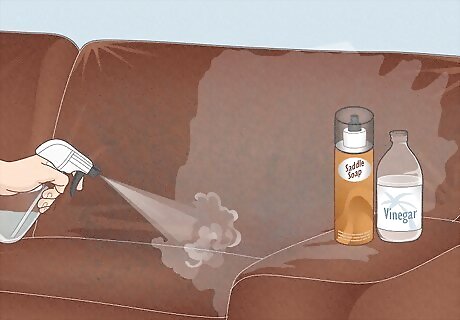
Clean your leather furniture. Cleaning leather furniture can be tricky because it must be treated gently and cannot be shampooed like a fabric. Using a gentle deodorizer can help you effectively remove the smoke smell from your leather furniture. Vacuum the soot off the furniture using a flat attachment. Do not rub the attachment along the surface of the leather furniture, as this can grind the soot in to the furniture further. Apply saddle soap or leather soap to a clean cloth and wipe the leather with it. Follow the instructions on the bottle for best results. Spray the leather with a half-vinegar half-water mixture mixed in a spray bottle. Because you cannot shampoo leather, this is your best bet for removing an odor. Wipe off this mixture, and then wipe furniture with a clean damp rag. Do not saturate the leather. Steam cleaning can also be effective for leather furniture. You can buy a steam cleaner for your home or hire professionals to do it for you. Sprinkle baking soda liberally over the leather and allow it to sit overnight. Vacuum it up in the morning, and repeat if needed. Remember to clean each cushion and pillow separately if your furniture has removable pieces.
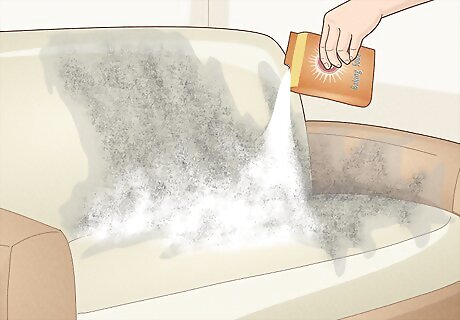
Clean your fabric furniture. Non-washable fabric furniture can stubbornly harbor smoke smells. You will want to clean these pieces of furniture as soon as possible as they will slowly leak the smoke smell into the rest of your house. If any fabric coverings can be removed from the furniture, do so. It is easiest to clean the smoke smell away in a washing machine.. You can also add 1 cup of white vinegar to the washing water in order to increase the power of odor removal. Sprinkle baking soda with a little bit of salt over the entire surface of the affected furniture. Baking soda is a well-known odor absorber. Allow the baking soda to sit for 1-2 days. Vacuum the baking soda away using the basic attachment on your vacuum cleaner. Repeat until the odor is removed. Consider purchasing a product called Odor Check by Watkins. This product is specifically found to work well for removing smoke smells.


















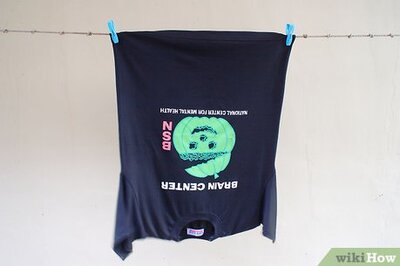

Comments
0 comment